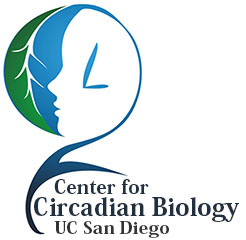Oscillator Networks
The biological clock in animals is comprised of oscillator networks of numerous cells, each of which has its own intracellular clock machinery. For example, the master mammalian circadian pacemaker is located in the suprachiasmatic nuclei (SCN) of the hypothalamus and consists of a network of ~20,000 neurons. The oscillatory behavior of the SCN network has additional emergent properties that arise from the interactions among its component cellular oscillators and that are responsible for some of the features that distinguish the mammalian biological clock from those of single-celled and other organisms. The study of these cellular oscillator networks illustrates the relevance of examining the structure and function of the biological clock at multiple levels of organization.
Coupling mechanisms in the SCN network synchronize the oscillatory output of neurons to produce a coherent output signal. Recent studies of SCN slices from mutant mice have revealed that the SCN network confers a robustness against genetic perturbations that is not present at the single cell level (Welsh, Kay). Moreover, the SCN has important internal structure as an oscillator network. Detailed analysis of spatiotemporal patterns of oscillatory gene expression in the SCN indicate that there is a reproducible sequence of activation across SCN subregions, and that some subregions are much more highly rhythmic than others (Welsh). Additionally, although resetting of circadian oscillations by light can be reconstituted even in fibroblasts (Panda, Welsh), the SCN contains specific anatomical pathways important for certain features of photic entrainment.
The CCB is promoting the study of the physiology of the SCN master pacemaker at both cellular and network levels. An exemplary area of inquiry is whether specific functional subtypes of SCN neurons exist, or whether functional differences observed across the intact network arise from network properties alone. Additionally, CCB investigators are exploring to what extent the oscillatory function of single SCN neurons depends on synaptic input and/or intracellular calcium levels. One approach to studying such issues is to study the physiology of labeled subtypes of SCN neurons (Panda). Another is to study how altering depolarization and/or calcium levels affects oscillatory function in SCN neurons (Welsh). A third is to examine how manipulation of specific intercellular signaling pathways affects SCN function (Kay).
Cross-disciplinary collaboration is a hallmark of the CCB, and investigation of oscillator networks is no exception. Exploration of oscillator networks at the cellular level complements studies approached from behavioral and physiological levels. For example, the circadian pacemakers of organisms from flies to humans have been designed to accommodate seasonal change in their environments by generating markedly different oscillations, presumably through altered interactions of component neural oscillators. Model systems have been developed that permit environmental manipulations to be used to produce novel biological clock entrainment patterns in hamsters and mice and to alter coupling between formally described circadian oscillators (Gorman). Ongoing work at the CCB aims to explore how SCN physiology and the performance of the SCN at the cellular network level yield the oscillatory features displayed at the behavioral level. CCB investigators are using tools such as in situ hybridization and luminescence imaging, at the molecular level, to probe fundamental questions about the control of circadian flexibility in such entrainment models.
